|
U-Boat Type IXA
by Brett Green
|
 |
|
U-Boat Type IXA
U-40 |

Mirage's
1/400 U-Boat Type IXA is available online from Squadron
Mirage's 1/400 scale U-Boot
IXA Turm 1 comprises less than 40 parts in grey plastic. At around 19cm
long, and around 1.5cm wide, it will not take up much shelf space.
Detail on the kit is quite
respectable. The deck features finely raised and engraved surface
features, and the flooding holes are deeply recessed into the top of the
hull sides. The deck guns look quite nice too. Even so, a few key features
are not represented or oversimplified because of the limitations of
injection moulding technology in this small scale. Some of the items
missing include the prominent railing on the Wintergraten platform
at the rear of the sail; the torpedo tube doors; and the rails along the
edge of the deck.
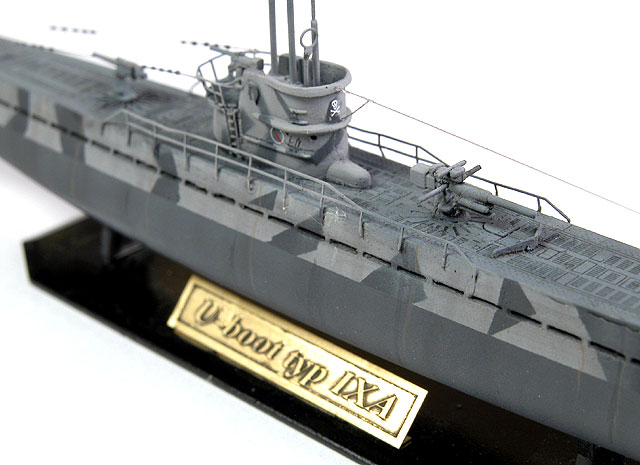
However, the model will
still be recognisable as a Type IXA U-Boat even without these attributes.
It will also be a very simple, fast model to build as a plain plastic kit.
Modellers who want to take
this kit to the next level may want to purchase the Mirage photo-etched
detail set. This set addresses the main areas missing in the kit including
the deck rails and the Wintergarten, while also replacing overscale
plastic parts in key areas. The etched set includes a full-length deck, a
new in-scale cable cutter, anchor, propeller detail parts, DF loop, deck
and sail details, plus some parts to detail the deck guns.
I decided to build one of Mirage's U-Boats after I saw
Scott Van
Aken's 1/400 U-1064 Type VII U-Boat on Modeling Madness last year. I
preferred the look of the larger Type IX U-Boat, and I also wanted to
build a subject with an interesting camouflage scheme if possible.
Mirage's good range of Type II, VII and IX U-Boats
included U-40, an early war submarine with a splinter camouflage scheme
and some interesting markings as well.
The photo-etched detail set for the Type IXA U-Boat was
released around August last year and Mirage kindly sent me an advance
sample. As soon as I saw this set I knew that I wanted to use it!
Construction started with the three-piece stand. I filled
the ejector pin marks in the vertical mounts, sanded them smooth and glued
them into the base of the mount. Next, I glued the hull halves and the
deck together.
 I
planned to use the photo-etched deck as a replacement, but the plastic
deck still needs to be installed to provide a solid foundation for the
flimsy photo-etched parts. I sliced off the larger raised details on the
deck, then used a large sanding stick to totally remove all raised detail
to provide a perfectly flat base for the new deck (click thumbnail at
right to view larger image). I
planned to use the photo-etched deck as a replacement, but the plastic
deck still needs to be installed to provide a solid foundation for the
flimsy photo-etched parts. I sliced off the larger raised details on the
deck, then used a large sanding stick to totally remove all raised detail
to provide a perfectly flat base for the new deck (click thumbnail at
right to view larger image).
The sail (conning tower) was then assembled. Detail was
sanded off the floor of the circular Wintergarten, as this was also
destined to receive a photoetched deck along with the new railing.

After sanding, I noticed a slight overhang that needed to
be filled underneath the deck on both sides of the hull. Milliput was used
for this task. The two-part epoxy putty was smoothed into place and sanded
flat when dry. I applied a coat of Mr Surfacer 1000 over the top of the
Milliput to ensure there were no pinhole gaps remaining. They would be
quite obvious in this scale!
I carefully removed the fore and aft deck sections from
the photo-etched fret and glued them into place on the plastic hull. The
fit was close to perfect.
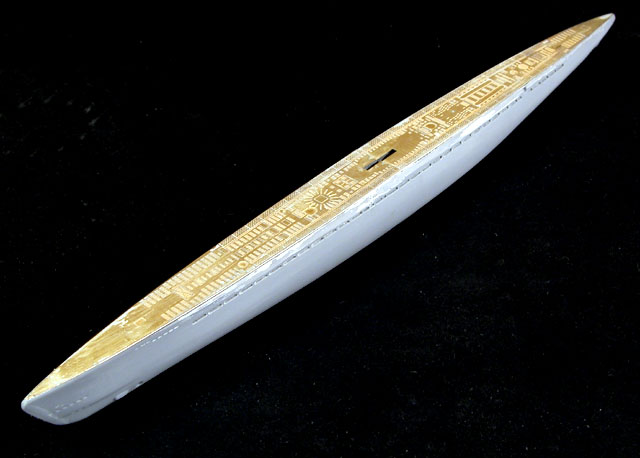
Before adding the floor and railing to the Wintergarten,
I thinned out the coaming at the front of the sail with a sharp hobby
knife. I also added periscopes and snorkel using lengths of fine metal
light filaments. A thin piece of brass rod was used to mount the
photo-etched direction finder loop. Some details were also added to the
outside of the sail including a handrail from wire and portholes (or
drainage holes?) drilled near the front. Photo-etched ladders were secured
at this stage too.
My biggest concern was folding the railing for the
Wintergarten. As it turns out, it was not too onerous. Care and time
are the best investments for a successful outcome. The folded brass
Wintergarten was glued to the back of the sail.
The weapons looked okay but I decided to add more detail,
especially to the 105mm main deck gun. Fine brass wire was added to
represent handles, hydraulics and optics. The barrels on the smaller guns
were replaced with copper wire.
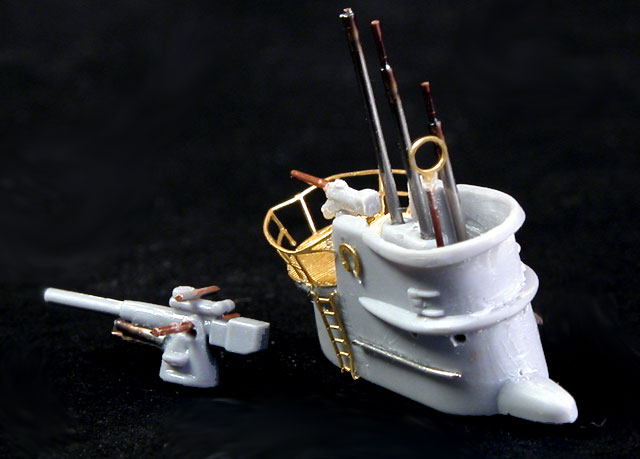
I bevelled the inside edges of the sail to help ensure a
gap-free fit on the deck. The sail was superglued in place and the model
was starting to look a lot more like a U-Boat!
The gorgeous, crisp deck surface texture was supplemented
with separate photo-etched parts for a splashguard in front of the 105mm
deck gun, non-slip flooring under both deck guns and bases for the
capstans. The capstans themselves were cut from lengths of brass wire and
glued in place.
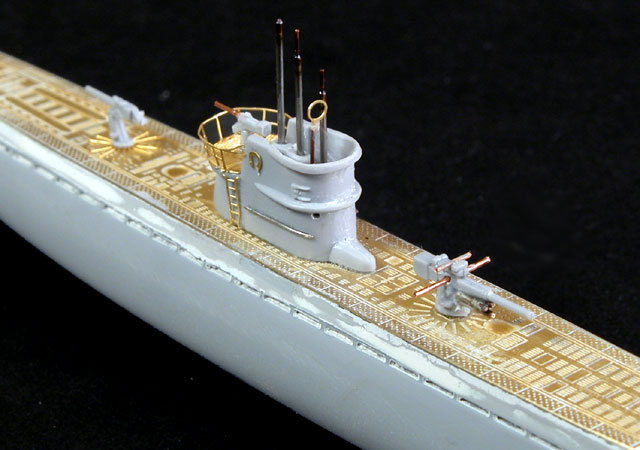
The lower hull details were next, including dive planes,
the photo-etched propellers combined with plastic driveshafts and rudders.
I did have a little trouble getting these parts to line up as the locating
points are not very positive. I think I got it right in the end!
The cable cutter assembly is just beautiful. It does
require some sharp folding though, so I waited until my Etch-Mate
photo-etched folding tool arrived before I attempted this assembly. The
Etch-Mate made easy work of the mount for the cutter, and the part was
mounted on the bow of the boat
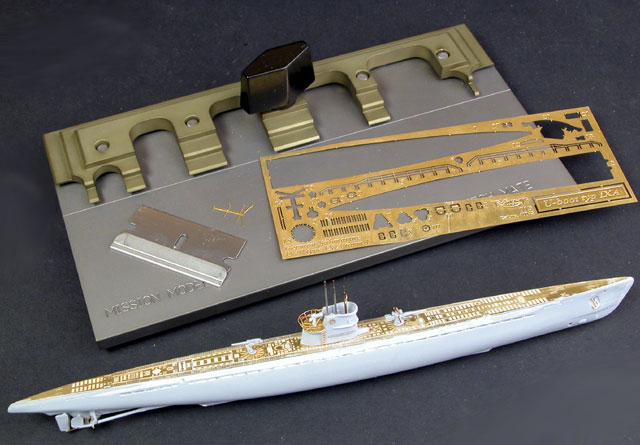
.
The hull railing is mercifully short and secures to the
side of the hull. Super glue was used to fasten the railings to the
vessel.
Click the thumbnails below
to view larger images:
I wanted to obtain a finish that was somewhat weathered
but not overdone considering the scale.
Painting
The model was painted with my Aztek A470 airbrush and a
fairly random selection of paints.
To start the paint job, the model was sprayed with an
overall coat of Tamiya German Grey. I then cut tiny masks from the
adhesive sections of Post-It Notes and stuck them to the hull and
sail sides.

Tamiya Sky Grey was sprayed over the entire model. When
the Post-It Note masks were removed, the camouflage pattern became
obvious.
Next, fine streaks were sprayed vertically along the hull
sides. XF-66 Light Grey was then applied with a fine paintbrush on the
main deck around the bottom of the sail and the Wintergarten, and sprayed
over the remainder of the deck.
The upper hull was now masked off with Tamiya masking
tape. A mix of Dark Grey and German Grey was applied to the lower hull.
While the upper hull was still masked off, thin streaks of a lighter grey
were sprayed vertically on the lower hull too.
Click the thumbnails below
to view larger images:
|
|

|
|
The basic camouflage pattern after removal of the Post-It Note masks
|
|

|
|
Vertical streaks have been applied to the hull sides and sail.
|
|

|
|
The deck receives a coat of Tamiya Light Grey...
|
|

|
|
...before the upper hull is masked and the lower hull is sprayed with a streaky Dark Grey mix.
|
|
|
Decals
Kit decals were used. I only sprayed the local areas where
the decals would be positioned with Testor's Metalizer Sealer. The kit
decals performed perfectly.
The glossy surfaces and decals were sealed with Polly
Scale acrylic Flat finish, sprayed undiluted through the Aztek airbrush.
A few additional vertical streaks were added to the hull.
These were applied with a fine paint brush using Dark Earth for rusty
stains and Light Grey for a little subtle variety.
Aerial wires and a lead-in wire to the sail were added
from smoke-coloured invisible mending thread (monofilament). The prominent
sets of floats on the wires were created by applying drops of super glue
to the threads after they were strung from the sail, fore and aft.
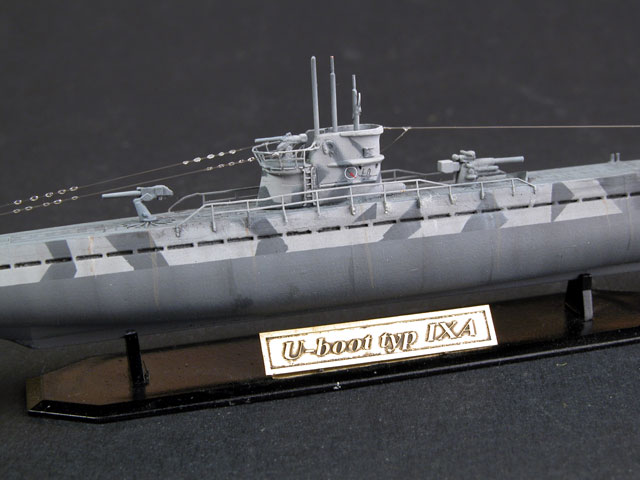
When the tiny drops of super glue had dried, they were
brush-painted dark grey.
This was my first maritime model since returning to the
hobby in the late 1980s. It was also the first time that I have used a
photo-etch bending tool.
I greatly enjoyed both experiences, and have bought quite
a few ship and submarine kits since starting this project last year.
If you want to dip your toe into ship modelling, but you
do not want to invest a fortune in kits and detail sets, Mirage's series
of 1/400 submarines and warships is a great place to start. The Type IXA
U-Boat that I built costs around USD$8.00; and the photo-etched set is
around the same price.
Considering the result, that sounds like a bargain to me!
Click the
thumbnails below to view larger images:
Model, Images and Text
Copyright © 2003 by
Brett Green
Page Created 21 May, 2003
Last Updated
17 March, 2004
Back to
HyperScale Main Page |
Home |
What's New |
Features |
Gallery |
Reviews |
Reference |
Forum |
Search